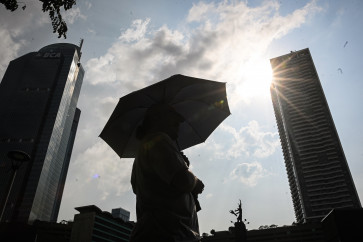Popular Reads
Top Results
Can't find what you're looking for?
View all search resultsPopular Reads
Top Results
Can't find what you're looking for?
View all search resultsAnalysis: Is the slowdown in the property sector set to continue?
The year 2015 has been a difficult period for the Indonesian property sector, with the real estate market continuing to slow into the third quarter of the year
Change text size
Gift Premium Articles
to Anyone
The year 2015 has been a difficult period for the Indonesian property sector, with the real estate market continuing to slow into the third quarter of the year. This is due, among other reasons, to the sluggish state of the national economy. On top of the general economic malaise of recent months, high interest rates have also had a direct, and adverse, impact on the performance of the property sector in Indonesia.
Bank Indonesia's Residential Property Price Survey in the third quarter of 2015 showed a slowdown in the growth of residential property prices in the primary market. This is reflected in the Residential Property Price Index (IHPR), which in the third quarter of 2015 grew by only 0.99 percent quarter-to-quarter (qtq), or 5.46 percent year-on-year (yoy), down from the growth recorded in the previous quarter of 1.38 percent qtq or 5.95 percent yoy.
Slowing price growth occurred in all categories of housing, with the small homes category suffering the largest downturn (1.02% qtq). The trend of slowing price rises is expected to continue into the fourth quarter of 2015.
The listless performance of the real estate sector was also reflected in the growth of residential real estate sales in the third quarter of 2015, which were recorded at 7.66 percent qtq, down from the previous quarter's figure of 10.84 percent qtq. Slowing sales were most keenly felt in the large home category. This development is in line with the slowdown in home credit (mortgage) growth. As of September 2015, the value of mortgage loans stood at Rp 318.94 trillion, with growth of just 8.05 percent yoy, lower than the growth recorded in January 2015 of 12.34 percent yoy.
The results of the Commercial Property Price Survey in the third quarter of 2015 showed a similar trend, revealing that growth in commercial real estate prices in the regions surveyed (namely Greater Jakarta, Banten, Bandung and Makassar) had weakened to 0.64 percent qtq, or 26.02 percent yoy, below that recorded in the previous quarter of 1.69 percent qtq, or 32.31 percent yoy.
The slowdown in price increases, as recorded on a quarterly basis, took place across nearly all segments, except for hotels and shopping centers. In addition to the poor performance of the price, the supply of commercial property also weakened. In the second quarter of 2015, meanwhile, the commercial property supply index pointed to growth of 1.2 percent qoq, while third-quarter growth was recorded at a mere 0.76 percent qoq.
On a similar note, Coldwell Banker Commercial Property Consultants reported that the overall performance of the commercial real estate market in the third quarter of 2015 was poor. This is confirmed from the fairly significant correction seen in the property sector in terms of demand. This came on the back of a depressed economy and delayed decision-making on transactions in the real estate sector as players take a wait-and-see approach.
The slowdown in the real estate sector this year is also evident from the poor performance of property companies in terms of pre-sales. For example, Sinarmas Land recorded pre-sales of Rp 4.62 billion from January to September of 2015, or just 61.57 percent of its total target for 2015 of Rp 7.50 billion. Similarly, over the first nine months of 2015, Alam Sutera Realty recorded pre-sales of Rp 1.46 billion, or approximately 32.53 percent of its total 2015 target of Rp 4.50 billion. Another company, Lippo Karawaci, achieved pre-sales of Rp 2.94 billion from January to September of 2015, or only about 53.37 percent of its total target for the year of Rp 5.51 billion.
Prospects for 2016
So, is the slowdown in the property sector slowdown set to continue into 2016? In our view, next year's prospects for the property sector are still relatively lackluster, but should record a slightly improved performance from this year. This is in line with the outlook for economic growth next year, which is a little better than this year. The office of Bank Mandiri's chief economist predicts that economic growth will reach 5.2 percent next year. Several factors give rise to this guarded optimism. The first is the positive sentiment stemming from the government's policy of easing loan-to-value (LTV) requirements and its property sector policy package, which limits the increase in sales tax on luxury goods (PPnBM) for luxury residences and opens up a discourse on the foreign ownership of property in Indonesia.
Recently, the government released a fifth economic policy package, which mainly aims at boosting investment in property and infrastructure sectors through removing a multiple tax imposed on a financial instrument known as a collective investment contract of real estate investment trust (REIT). REIT is a financial instrument with underlying assets such as property or infrastructure. Property companies used to create a subsidiary to turn their real assets into underlying assets, for REIT securities. They raised funds by selling and listing the REITs on capital markets abroad, such as in Singapore. The removal of double taxation on REIT transactions is expected to attract real estate investment funds placed overseas or in real estate investment trusts in Indonesia and eventually will be able to boost the property sector as an alternative funding scheme for property companies.
Furthermore, the rupiah has shown some signs of strengthening against the US dollar recently and proposed infrastructure development should soon spur the real sector, thereby increasing purchasing power. All these signs seem to indicate that economic improvement is only a matter of time.
The second factor underlying this optimism is that the real estate sector traditionally experiences cycles. A simplified way of explaining these cycles is that the property sector's fortunes historically fluctuate ' sometimes real estate struggles, supply exceeds demand, property prices fall and operating margins narrow. However, this might just as easily go the other way, with the real estate sector picking up, demand exceeding supply, property prices soaring and operating margins widening.
The reasons for these cycles are numerous and diverse. There is an assumption that they are caused by real estate players making inaccurate demand projections, sometimes leading to the flooding of the market and at other times causing a supply shortfall. Other analysts speculate that they stem from unfavorable economic conditions and inappropriate government policies that are to the detriment of the property business.
With further respect to these cycles, it is worth noting that the real estate sector enjoyed a boom in 2012 preceded by sharply accelerating growth from 2009 to 2011. The expansion of the housing market from 2010 to 2012 was indeed incredible, with growth in mortgages of up to 44.52 percent yoy recorded in July 2012. The increase in mortgage growth at the time went hand-in-hand with significant rising sales and selling prices. Booms of several years tend to be followed by market saturation and this is precisely what began happening in 2013, with a continual decline into this year.
___________________________________
The writer is an industry analyst at Bank Mandiri.










